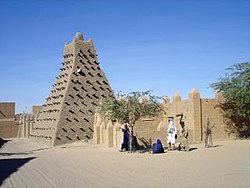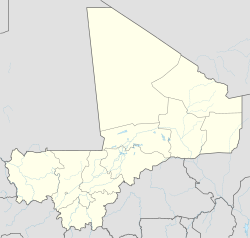Timbuktu
Timbuktu Tombouctou | |
|---|---|
Ceety | |
| transcription(s) | |
| • Koyra Chiini: | Tumbutu |
 Sankore Mosque in Timbuktu | |
 Map showin the main trans-Saharan caravan routes in around 1400. Shown an aw are the Ghana Empire (till the 13t century) an 13t – 15t century Mali Empire. Note the wastren route runnin frae Djenné via Timbuktu tae Sijilmassa. Present day Niger in yellae. | |
| Coordinates: 16°46′33″N 3°00′34″W / 16.77583°N 3.00944°WCoordinates: 16°46′33″N 3°00′34″W / 16.77583°N 3.00944°W | |
| Kintra | Mali |
| Region | Tombouctou Region |
| Cercle | Timbuktu Cercle |
| Settled | 12t century |
| Elevation | 261 m (856 ft) |
| Population (2009)[1] | |
| • Total | 54,453 |
| Teep | Cultural |
| Criteria | ii, iv, v |
| Designatit | 1988 (12th session) |
| Reference no. | 119 |
| State Party | Mali |
| Region | Africae |
| Endangered | 1990–2005 |
Timbuktu (Koyra Chiini: Tumbutu; French: Tombouctou), umwhile spelt Timbuctoo an Timbuktoo an aw, is a ceety in the Wast African naition o Mali situatit 15 km (9.3 mi) north o the River Niger on the soothren edge o the Sahara Desert. It is the caipital o the Timbuktu Region, ane o the aicht admeenistrative regions o Mali. It haed a population o 54,453 in the 2009 census.
History
[eedit | eedit soorce]Stairtin oot as a saisonal dounset, Timbuktu became a permanent dounset early in the 12t century. Efter a shift in tradin routes, Timbuktu flourished frae the trade in salt, gowd, ivory an slaves, an it became pairt o the Mali Empire early in the 13t century. In the first hauf o the 15t century the Tuareg tribes teuk control o the ceety for a short period till the expandin Songhay Empire absorbit the ceety in 1468. A Moroccan airmy defeatit the Songhay in 1591, an made Timbuktu, rather than Gao, thair stranghauld. The invaders established a new rulin class, the arma, who efter 1612 became independent o Morocco. Housomeivver, the gowden age o the ceety wis ower an it entered a lang period o decline. Different tribes govrened till the French teuk ower in 1893, a situation that lastit till it became pairt o the current Republic o Mali in 1960. Presently Timbuktu is impoverished an suffers frae desertification. Several initiatives are bein unnertaken tae restore the historic manuscripts still kept in the ceety. Meanwhile, tourism forms an important soorce o income.
In its Gowden Age, the toun's numerous Islamic scholars and extensive trading network made possible an important beuk trade: thegither wi the campuses o the Sankore madrassah, an Islamic varsity, this established Timbuktu as a scholarly centre in Africae. Several notable historic writers, sic as Shabeni an Leo Africanus, hae describit Timbuktu. Thir stories fuelled speculation in Europe, whaur the ceety's reputation shiftit frae bein extremely rich tae bein mysterious. This reputation owershadows the toun itsel in modren times, tae the pynt whaur it is best kent in Wastren cultur as an expression for a distant or ootlandish place.
On 1 Aprile 2012, ane day efter the captur o Gao, Timbuktu wis captured frae the Malian militar bi the Tuareg rebels o the MNLA an Ansar Dine.[2] Five days later, the MNLA declared the region independent o Mali as the naition o Azawad.[3] The newly declared poleetical entity haes no been recognizit bi ony local naitions or the internaitional commonty.[4]
Climate
[eedit | eedit soorce]The wather is het an dry throughoot hintle o the year. Average daily maximum temperaturs in the hettest months o the year – Aprile, Mey an Juin – exceed 40 °C (104 °F). Lawest temperaturs occur durin the Northren Hemisphere winter – December, Januar an Februar. Housomeivver, average maximum temperaturs dae no drop belaw 30 °C (86 °F). Thir "winter" months are characterizit bi a dry, dusty trade wind blowin frae the Saharan Tibesti Region soothwaird tae the Guwf o Guinea: pickin up dust pairticles on thair wey, thir winds leemit visibility in wha haes been dubbit the 'Harmattan Haze'.[5] Additionally, when the dust settles in the ceety, saund builds up an desertification looms.[6] Timbuktu's climate is classifeed as BWhw accordin tae the Köppen Climate Classification: arid, wi nae month averagin belaw 0 °C (32 °F) an a dry saison durin winter.
| Climate data for Timbuktu | |||||||||||||
|---|---|---|---|---|---|---|---|---|---|---|---|---|---|
| Month | Jan | Feb | Mar | Apr | May | Jun | Jul | Aug | Sep | Oct | Nov | Dec | Year |
| Record heich °C (°F) | 36 (97) |
39 (102) |
42 (108) |
45 (113) |
48 (118) |
47 (117) |
47 (117) |
43 (109) |
47 (117) |
47 (117) |
40 (104) |
42 (108) |
48 (118) |
| Average heich °C (°F) | 30.0 (86.0) |
33.2 (91.8) |
36.6 (97.9) |
40.0 (104.0) |
42.2 (108.0) |
41.6 (106.9) |
38.5 (101.3) |
36.5 (97.7) |
38.3 (100.9) |
39.1 (102.4) |
35.2 (95.4) |
30.4 (86.7) |
36.8 (98.3) |
| Average law °C (°F) | 13.0 (55.4) |
15.2 (59.4) |
18.5 (65.3) |
22.5 (72.5) |
26.0 (78.8) |
27.3 (81.1) |
25.8 (78.4) |
24.8 (76.6) |
24.8 (76.6) |
22.7 (72.9) |
17.7 (63.9) |
13.5 (56.3) |
21.0 (69.8) |
| Record law °C (°F) | 5 (41) |
8 (46) |
7 (45) |
10 (50) |
15 (59) |
21 (70) |
17 (63) |
21 (70) |
18 (64) |
12 (54) |
7 (45) |
1 (34) |
1 (34) |
| Average precipitation mm (inches) | 0.6 (0.02) |
0.1 (0.00) |
0.1 (0.00) |
1.0 (0.04) |
4.0 (0.16) |
16.4 (0.65) |
53.5 (2.11) |
73.6 (2.90) |
29.4 (1.16) |
3.8 (0.15) |
0.1 (0.00) |
0.2 (0.01) |
182.8 (7.2) |
| Average rainy days | 1 | 0 | 0 | 0 | 1 | 1 | 3 | 4 | 3 | 1 | 0 | 0 | 14 |
| Source #1: World Meteorological Organization[7] | |||||||||||||
| Source #2: Weatherbase[8] | |||||||||||||
Sister ceeties
[eedit | eedit soorce]Timbuktu is a sister ceety tae the follaein ceeties:[9]
- Chemnitz, Germany
- Hay-on-Wye, Wales, Unitit Kinrick
- Kairouan, Tunisie
- Marrakech, Morocco
- Saintes, Fraunce
- Tempe, Arizona, Unitit States
- Tifariti, Sahrawi Arab Democratic Republic (Wastren Sahara)
References
[eedit | eedit soorce]- ↑ Resultats Provisoires RGPH 2009 (Région de Tombouctou) (PDF), République de Mali: Institut National de la Statistique, archived frae the original (PDF) on 17 Mairch 2013, retrieved 21 Apryle 2017
- ↑ Rukmini Callimachi (1 Apryle 2012). "Mali coup leader reinstates old constitution". Associated Press. Retrieved 31 Mairch 2012.
- ↑ "Tuareg rebels declare the independence of Azawad, north of Mali". Al Arabiya. 6 Apryle 2012. Retrieved 6 Apryle 2012.
- ↑ Azawad: the latest African Border Dilemma, Walter G. Moseley, Al Jazeera, 18 April 2012
- ↑ Adefolalu, D.O. (25 December 1984). "On bioclimatological aspects of Harmattan dust haze in Nigeria". Meteorology and Atmospheric Physics. New York, NY: Springer Wien. 33 (4): 387–404. doi:10.1007/BF02274004. Retrieved 14 Februar 2011.[deid airtin]
- ↑ Benjaminsen, Tor A; Berge, Gunnvor (2004). "Myths of Timbuktu: From African El Dorado to Desertification". International Journal of Political Economy. Armonk, NY: M.E. Sharpe, Inc. 34 (1): 31–59. Retrieved 14 September 2010.
- ↑ World Weather Information Service – Tombouctou (1950-2000), World Meteorological Organization, retrieved 14 Februar 2011
- ↑ "Weatherbase: Weather For Timbutku, Mali". Weatherbase. 2011. Archived frae the original on 26 December 2018. Retrieved 2 Juin 2012. Retrieved on November 23, 2011.
- ↑ "Timbuktu 'twins' make first visit". BBC News. British Broadcasting Corporation. 24 October 2007. Retrieved 24 Mey 2010.
Freemit airtins
[eedit | eedit soorce]| Wikimedia Commons haes media relatit tae Timbuktu. |
Template:Niger River
Template:Communes o the Tombouctou Region
| This Africae-relatit airticle is a stub. Ye can help Wikipaedia bi expandin it. |
| This ceity-relatit airticle is a stub. Ye can help Wikipaedia bi expandin it. |

